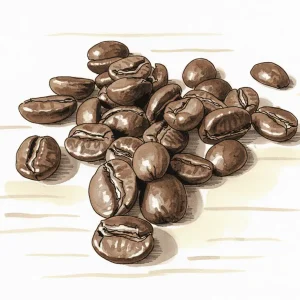ARABICA
Arabica coffee has been cherished for centuries for its refined flavors and vibrant aromatics. Originating in Ethiopia, it quickly spread to Yemen and beyond, creating diverse regional profiles. Grown at higher elevations, it yields a sweet taste with delicate acidity. Optimal processing methods, such as washed or natural, highlight the beans' complexity, making Arabica a favorite among specialty roasters worldwide.
ARABICA Beans
Showing 65–80 of 734 results
De goedkoopste prijzen per 1 kg worden weergegeven
-
Brazil - Campo Alegre Espresso
€ 131,80 -
Brazil – Cascavel Verde – Pulped Natural
van Back to Black€ 130,20 -
Brazil – Fazenda Santa Cruz
van Koffiestation€ 35,00 -
Brazil – Leandro Santos – Fazenda Boa Vista – Washed
van Back to Black -
Brazil – Serra Dos Ciganos (zeiltransport)
van Koffiestation€ 40,50 -
Brazil & Colombia - Five Points Blend - Natural & Washed
van Five Ways Coffee€ 30,00 -
Brazil Classic – Peaberry
€ 118,40 -
Brazil Daterra Sweet Collection Coffee Beans
van Evermore€ 35,00 -
Brazil DECAF
€ 139,60 -
Brazil Fazenda Bioma
van Fascino Coffee€ 26,95 -
Brazil Fazenda Sequóia
van Blue’s Coffee€ 102,00 -
Brazil Santos
€ 457,80 -
Brazil Santos Diamond Piatta
€ 30,00 -
Brazil Santos Espresso
van Boot Koffie€ 39,00 -
Brazilian Swiss Water Decaf Coffee
van Brazuca Coffee€ 32,90 -
Brazilië
€ 108,00
More About ARABICA
History of Arabica
Arabica coffee (Coffea arabica) traces its roots back to the 9th century in the southwestern highlands of Ethiopia. According to local legends, goat herders noticed their goats becoming unusually energetic after consuming the cherries from a certain bush. This discovery eventually led to the domestication and cultivation of Arabica beans. Over time, traders from the Arabian Peninsula introduced these beans to Yemen, where the first coffee plantations emerged in the 15th century. Historical records often attribute advancements in coffee cultivation to early Yemeni farmers who perfected various processing methods, setting the stage for Arabica’s global spread.
Major Growing Regions
Today, Arabica is primarily grown in countries along the so-called “Coffee Belt,” which includes Latin America (notably Brazil and Colombia), East Africa (Ethiopia and Kenya), and parts of Southeast Asia. Altitudes between 1,200 and 2,200 meters above sea level are typically preferred. Brazilian Arabica often delivers a balanced, nutty profile, while Ethiopian varieties exhibit floral and citrusy notes. Colombian beans are known for a fuller body and complex aromas, and Kenyan Arabica tends to have bright acidity with berry undertones. Each region’s soil composition, climate, and elevation play significant roles in shaping the final taste.
Flavor and Aromatic Profiles
Arabica generally offers a sweeter, smoother cup compared to other coffee varieties, with notes that can range from chocolate and caramel to fruity or floral. Its acidity is often described as bright or delicate, contributing to a refined mouthfeel. Aroma can vary widely, from jasmine-like floral scents to deep, earthy undertones, depending on the origin. The average caffeine content is lower than other varieties, which can make the flavor more nuanced.
Preferred Processing Methods
Arabica beans flourish under both washed and natural processing methods. Washed processing highlights a cleaner, more consistent flavor, often used in places like Colombia and Costa Rica. Natural (dry) processing is popular in Ethiopia and Brazil, resulting in fruitier notes and a heavier body. Honey processing, common in Central America, provides a balance of both methods, retaining sweetness while maintaining some clarity in the cup.
Best Brewing Techniques
Arabica reveals its complexity best in methods that emphasize clarity and delicate flavors. Pour-over techniques (such as V60 or Kalita Wave) bring out brighter acidity and floral notes. Espresso concentrates flavor and intensifies sweetness, while still preserving Arabica’s inherent smoothness. French press can highlight a fuller body and deeper chocolatey tones. Each method showcases a different aspect of Arabica’s flavor spectrum, making it a versatile choice.
Climate Influence
Temperature ranges between 18°C and 22°C are considered optimal for Arabica plants. Excessively hot or cold conditions can slow growth and affect bean development, altering sweetness and acidity levels. Rainfall patterns and humidity also play a role in disease susceptibility; regions with consistent rainfall often produce more stable harvests and vibrant flavor profiles.
Disease Resistance and Sustainability
Arabica is more susceptible to diseases such as coffee leaf rust (Hemileia vastatrixArabica is more susceptible to diseases like coffee leaf rust (Hemileia vastatrix) compared to Robusta. However, research institutions in Brazil and East Africa have made progress in developing more resilient Arabica strains, such as varieties known as Catuaí and SL28. Climate change remains a challenge, but selective breeding and responsible farming practices aim to preserve the variety’s quality and availability for future generations.
Arabica vs. Other Varieties
Arabica typically contains less caffeine than Robusta, leading to a milder taste that many specialty roasters prefer. On the downside, the plants can be more fragile and yield smaller harvests, driving up production costs. Robusta is more disease-resistant and thrives at lower elevations, but often lacks the complexity that Arabica enthusiasts seek.
Popularity Among Roasters
Around 60% of the world’s coffee production is devoted to Arabica beans. Specialty roasters in Amsterdam, such as White Label Coffee or Bocca Coffee Roasters, frequently highlight Arabica single-origin offerings, emphasizing distinct regional characteristics. Coffee professionals often gravitate toward Arabica because it presents a broad range of flavors and complexities.
Recommended Settings for Perfect Extraction
A medium-to-fine grind setting is generally ideal for pour-over or drip methods. For espresso, a fine grind that allows an extraction time of around 25 to 30 seconds is recommended. Water temperature between 90°C and 96°C ensures a balanced extraction, preserving Arabica’s delicate aromas while highlighting its sweetness. Adjustments may be necessary for different regional beans or roast levels to achieve the most vibrant flavor profile.

